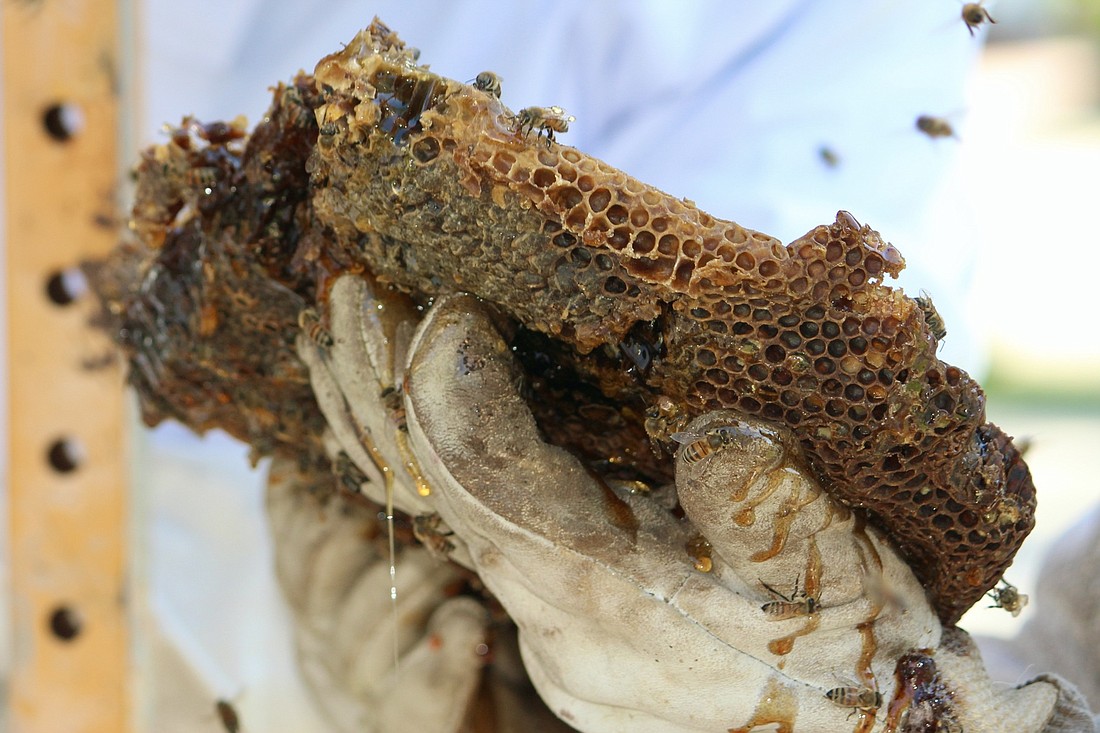- July 26, 2024
-
-
Loading

Loading

This article has been update to correct the spelling of Tony Woodard.
No, that wasn't a hazardous-materials team at work on Tarawitt Drive recently. Just a neighbor helping a neighbor.
With some bees. Make that a lot of bees.
Six people donned white head-to-toe bee suits: two hobbyist beekeepers, two homeowners, one contractor and one Longboat Observer reporter. To a passerby, the group could have passed for the Ghostbusters.
But the minute Tony Woodard started prying at the home’s soffit, there was no mistaking the home's buzz-worthy occupants. How this hermetically sealed half-dozen came together on a hot Friday is a story that goes beyond beekeeping and neighborly acquaintances.
It's a tale of the right people (and honey-making insects) in the right place at the right time.
Meet J.C. and Jennifer Dominguez, who enjoyed their Longboat Key vacations so much that they bought their own place on Tarawitt Drive in 2020. Then in April, they bought another, essentially to share with their family.
"When this came up, and now our kids are older and my nephews are older, and it’s just like, 'Oh, my gosh, if we could just have another family home where everyone could come and stay together, that would be really nice,'" Jennifer said about their recent purchase.
What they hadn't counted on was a massive hive, which had gone undetected for years.
"I thought it went all the way up the wall." Jennifer said.
The Dominguezes know the Woodard and his wife, Arby Crawford, because they’re neighbors across the canal and were invited over for drinks when they first moved in. Woodard began beekeeping during the COVID-19 quarantine because his fruit trees weren’t looking good and it gave him something to do.
Woodard and Crawford have lived on Longboat for 32 years. Crawford’s family has had ties to the island since the 1930s. She suggested bees might help their trees but had two requests: one hive only, and make it look pretty.
Woodard made good on one out of the two requests; he etched the outline of a bee on each of his six handmade, wooden bee boxes that are used for hives. Six is all the town will allow.
“It’s a hobby that got a bit away from me,” he said, adding that his first foray into moving bees was for his friend, Harry Christensen, who had bees move into an owl box in his back yard.
Back at Tarawitt Drive shortly after the Dominguezes' April purchase, landscapers discovered a swarm on the property and alerted the new owners. Knowing that their across-the-canal friend knew bees, they made a call and ordered a pair of bee suits on Amazon. A few bee stings later, Woodard went to work removing the remaining bees to a new home in Myakka City.
Why so far?
If the bees were moved to the other side of the key, they would fly back to the same soffit, Woodard said. They need to be moved more than 15 miles away to ensure they don’t return.
Driving the bees out to Myakka was the quick and easy portion of the day. Coaxing them into the wooden boxes took nearly three hours. Woodard had to vacuum them up first. He attached a Shop-Vac to a specially designed box with a cage inside. The cage allows air to flow but traps the bees. With a sliding door on the bottom, Woodard then transferred the bees out of the bottom into a transport box filled with honeycomb.
Woodard removed about 8 feet of hives. Honeycombs were falling out of the soffit and filled three 5-gallon buckets and two wooden boxes. By the end of the day, his hands were swollen inside his gloves from what he estimated to be about 30 or 40 stings.
When the material gets wet, bees can sting through clothes and gloves, but they deliver less venom so it’s more like being pricked. Woodard laughed and said “it tickles a little bit.”
Woodard doesn’t usually end up covered in stings and slathered in honey, but this was an enormous hive.
“That comb on the outside was just black,” he said, “It’s at least 5 years old. If I had to guess, 8 or 9, maybe 10.”
The older the honey, the more it looks and tastes like molasses, Woodard said. It's edible for humans or bees, but the bees won't touch it unless it's the only honey available. Woodard's backyard honey is fresh and golden. It’s also for sale. His hobby turned into a cottage business, Longboat Bee & Honey, but he doesn’t advertise.
“I just put a little sign out in my front yard,” he said. “People who are brave come knock on the door.”
If you’re craving honey and feeling brave, knock on Woodard’s door at 793 St. Judes Drive N.